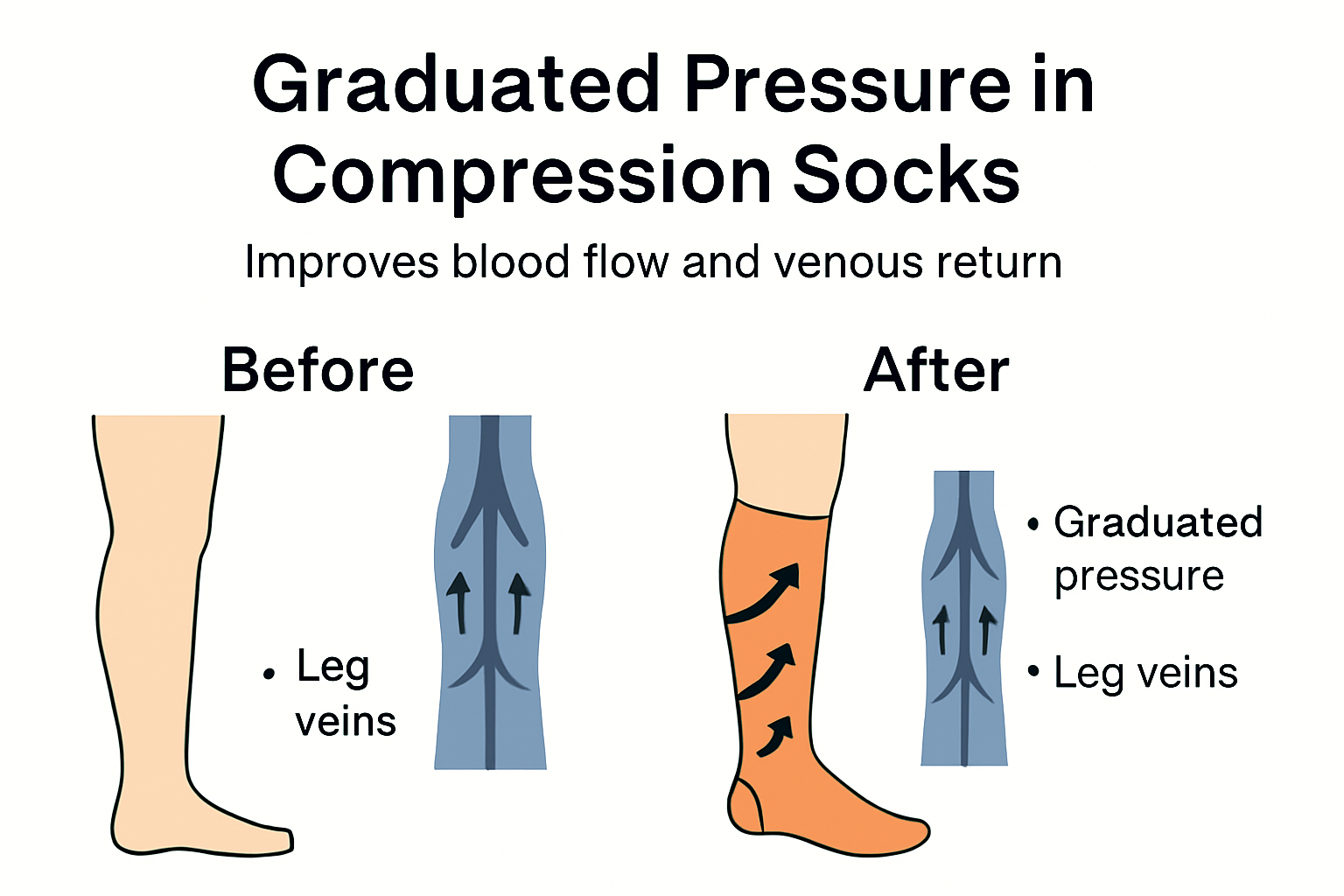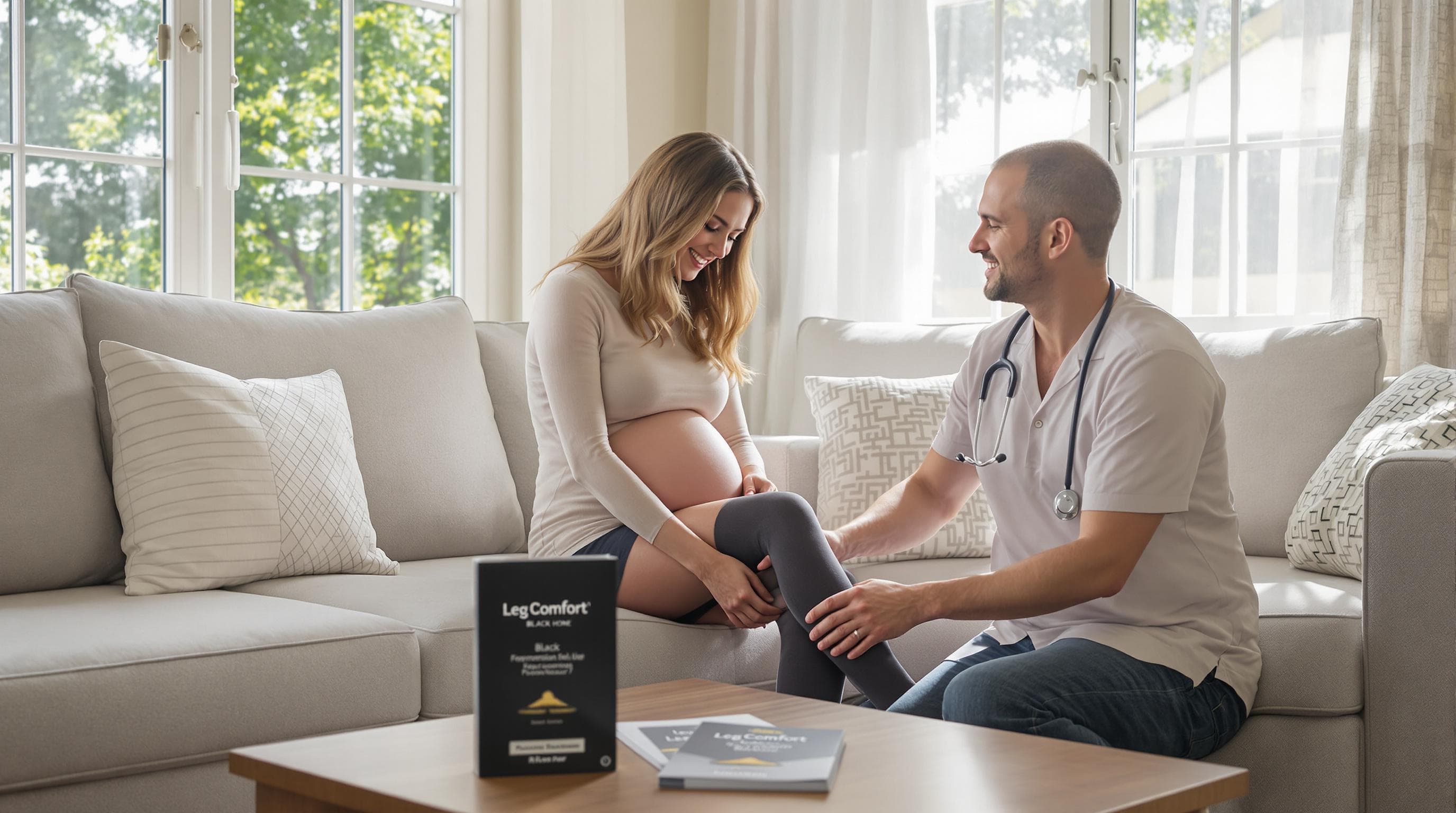
Top Benefits of Compression Socks for Health in 2025
Share

Compression socks are being used by more people than ever before. Here is something wild. A medical study showed they can increase lower limb blood flow by up to 24 percent. Most people think compression socks are just for older adults or athletes. The truth is they are now a simple solution for anyone who wants better circulation, everyday comfort, and healthier legs in 2025.
Table of Contents
- How Compression Socks Improve Blood Flow
- Key Benefits for Vein and Circulatory Health
- Compression Socks for Pregnancy and Everyday Support
- Choosing the Right Compression Socks for Your Needs
Quick Summary
| Takeaway | Explanation |
|---|---|
| Compression socks enhance blood flow | They utilize graduated pressure to create a pumping action that improves venous return and reduces risks of blood pooling and circulatory issues, such as deep vein thrombosis. |
| Support for specific conditions | Compression socks are effective for managing chronic venous insufficiency, alleviating varicose vein symptoms, and preventing circulatory complications, making them essential for individuals with cardiovascular challenges. |
| Benefits during pregnancy | These socks provide crucial support for pregnant women by addressing circulatory changes, reducing leg pain, and lowering the risk of thromboembolic events. |
| Choosing the right compression level | Understanding pressure levels is important; typical levels recommended for various conditions range from mild to extra firm, requiring professional consultation for the appropriate fit. |
| Importance of proper fitting | Accurate measurement ensures optimal effectiveness of compression socks, as improper fitting can lead to complications like skin irritation. |
How Compression Socks Improve Blood Flow
The Science of Graduated Pressure
Compression socks operate on a precise engineering principle known as graduated compression. Unlike regular socks, they apply strategic pressure that is highest at the ankle and gradually decreases toward the knee. Learn more about compression mechanics in our comprehensive guide.
According to Cleveland Clinic, this graduated design creates a consistent pumping action that significantly enhances blood return to the heart. By applying external pressure, these socks effectively combat gravitational challenges that typically impede lower limb circulation.

Physiological Impact on Venous Return
The primary function of compression socks centers on improving venous return—the process of blood flowing back to the heart against gravitational forces. A groundbreaking study published in the Journal of Vascular Research demonstrated that compression socks can increase popliteal vein peak systolic velocity by 24%, indicating substantial improvements in lower limb blood flow.
When worn consistently, compression socks help prevent blood pooling in lower extremities. This reduction in stagnant blood circulation minimizes risks associated with prolonged immobility, such as deep vein thrombosis and leg swelling. The consistent pressure encourages blood to move more efficiently through veins, reducing inflammation and supporting overall cardiovascular health.
Enhanced Arterial Performance and Recovery
Beyond venous benefits, compression socks also positively impact arterial performance. Research from the National Institutes of Health revealed that compression garments can improve arterial compliance, resulting in reduced brachial-ankle pulse wave velocity—a key indicator of arterial elasticity.
Athletes and active individuals particularly benefit from this enhanced circulation. Improved blood flow means faster muscle recovery, reduced lactic acid buildup, and decreased muscle fatigue. By supporting efficient blood movement, compression socks help optimize both performance and post-exercise recovery.
Whether you’re managing a medical condition, seeking athletic performance enhancement, or simply wanting to support your circulatory health, compression socks offer a scientifically backed solution for improved blood flow and overall vascular wellness.
Key Benefits for Vein and Circulatory Health
Compression socks provide critical support for individuals struggling with vein and circulatory health challenges. These specialized garments offer more than simple comfort—they represent a proactive approach to managing complex cardiovascular conditions.
Managing Chronic Venous Insufficiency
Chronic venous insufficiency represents a significant circulatory challenge where leg veins struggle to return blood efficiently to the heart. Discover more about managing vein health through targeted compression therapy.
According to Cleveland Clinic, compression therapy can dramatically improve blood flow by squeezing leg muscles and helping push blood against gravitational forces. This mechanical intervention reduces swelling, prevents blood pooling, and minimizes the risk of developing potentially dangerous circulatory complications.
Alleviating Varicose Vein Symptoms
Varicose veins affect millions, causing significant discomfort and aesthetic concerns. WebMD confirms that compression stockings can substantially reduce the pain and swelling associated with this condition. By applying graduated pressure, these socks help minimize vein distension and support overall vascular health.
The strategic compression helps counteract the underlying mechanisms that cause varicose veins. When vein walls become weak and valves malfunction, blood can flow backward and pool in the lower extremities. Compression socks create external support that helps veins maintain proper blood flow direction, reducing inflammation and preventing further vascular deterioration.
Preventing Circulatory Complications
Beyond immediate symptom management, compression socks play a preventative role in circulatory health. They are particularly beneficial for individuals at higher risk of circulatory complications, including people with diabetes, those with limited mobility, and individuals who spend extended periods standing or sitting.
Research indicates that consistent use of compression socks can significantly reduce the risk of deep vein thrombosis, a potentially life-threatening condition characterized by blood clot formation in deep leg veins. By promoting continuous blood movement and preventing stasis, these garments serve as a critical tool in maintaining long-term vascular wellness.
Whether managing an existing condition or seeking preventative care, compression socks offer a scientifically supported solution for maintaining optimal vein and circulatory health. Their ability to provide targeted support makes them an essential component of comprehensive cardiovascular wellness strategies.
Compression Socks for Pregnancy and Everyday Support

Pregnancy brings remarkable physical changes that can challenge a woman’s circulatory system. Compression socks emerge as a critical support tool, offering comfort and health benefits during this transformative period. Learn more about pregnancy support options.
Addressing Pregnancy-Related Circulatory Challenges
During pregnancy, a woman’s body undergoes significant physiological transformations that can impact blood circulation. Research published in the Journal of Obstetrics and Gynecology demonstrated that compression stockings can dramatically improve quality of life for pregnant women.
A comprehensive study involving 98 pregnant women revealed remarkable outcomes. Participants using compression socks experienced significant reductions in leg pain (a decrease of -17 ± 10.1 compared to -4.2 ± 9.8 without compression). The research also highlighted enhanced overall quality of life scores, showing substantial improvements in comfort and well-being.
Preventing Pregnancy-Related Circulatory Complications
Compression socks play a crucial role in mitigating potential circulatory risks during pregnancy. A clinical study examining 15 pregnant women found that compression stockings improved venous pump function and increased blood flow velocity in the superficial femoral vein, substantially reducing the risk of thromboembolic events.
Moreover, another fascinating study revealed unexpected benefits. A randomized crossover trial with 58 pregnant women discovered that compression stockings not only supported circulation but also positively impacted early pregnancy symptoms. The study showed a significant improvement in Nausea and Vomiting in Pregnancy Quality of Life (NVPQOL) scores.
Everyday Comfort and Support
Beyond pregnancy, compression socks offer versatile support for everyday activities. They provide consistent pressure that helps manage swelling, reduce fatigue, and support individuals with varying mobility levels. Whether standing for long hours, traveling, or managing mild circulatory concerns, these garments offer a practical solution for maintaining leg health.
For professionals who spend extended periods standing or sitting, compression socks can prevent leg fatigue, reduce muscle soreness, and promote better blood circulation. Athletes, healthcare workers, travelers, and individuals with sedentary lifestyles can all benefit from the targeted support these specialized socks provide.
Compression socks represent more than just a garment—they are a proactive approach to personal health management. By providing graduated pressure and supporting natural circulatory processes, they offer a simple yet effective method for maintaining leg comfort and overall well-being during pregnancy and beyond.
Choosing the Right Compression Socks for Your Needs
Selecting the appropriate compression socks requires careful consideration of individual health needs, lifestyle factors, and specific medical conditions. Discover expert guidance on selecting your perfect compression socks.
Understanding Compression Levels
Below is a summary table outlining common compression levels, their pressure range, and recommended use cases based on information from the article.
| Compression Level | Pressure (mmHg) | Typical Uses |
|---|---|---|
| Mild | 8-15 | Preventative care, mild swelling, daily comfort |
| Moderate | 15-20 | Minor varicose veins, mild swelling, travel prevention |
| Firm | 20-30 | Chronic venous disease, job-related leg swelling |
| Extra Firm | 30-40 | Severe venous insufficiency, requires medical supervision |
Compression socks are categorized by pressure levels measured in millimeters of mercury (mmHg), which determine their therapeutic effectiveness. Research published in Vascular Medicine indicates that different pressure levels address specific medical conditions.
Typical compression levels range from mild (8-15 mmHg) to extra firm (30-40 mmHg). According to clinical research, a 20-30 mmHg compression level is recommended for managing chronic venous disease and reducing job-related leg swelling. Lower levels work well for preventative care, while higher levels require medical professional consultation.
Professional Measurement and Proper Fitting
To help you better understand the fitting considerations discussed in the article, here’s a checklist table summarizing key factors for professional measurement and fitting accuracy.
| Measurement/Consideration | Importance |
|---|---|
| Leg circumference at multiple points | Ensures optimal compression |
| Length of leg from heel to knee | Selects appropriate sock length |
| Ankle and calf muscle dimensions | Customizes fit for effectiveness |
| Individual comfort and mobility needs | Prevents discomfort or complications |
Accurate measurement is crucial for compression sock effectiveness. Medical research emphasizes that improper fitting can lead to complications such as skin irritation or pressure necrosis. Healthcare professionals recommend precise limb diameter measurements to ensure optimal sock performance.
Key fitting considerations include:
- Leg circumference at multiple points
- Length of leg from heel to knee
- Ankle and calf muscle dimensions
- Individual comfort and mobility requirements
Selecting Socks for Specific Conditions
Compression socks are not one-size-fits-all solutions. Different medical conditions and lifestyle needs demand specialized approaches. Athletes might prefer performance-oriented designs, while professionals with sedentary jobs might need circulation-enhancing models.
Consider these factors when choosing compression socks:
- Medical history and current health conditions
- Occupation and daily activity levels
- Personal comfort preferences
- Aesthetic considerations
Consulting with healthcare professionals ensures you select compression socks tailored to your unique physiological requirements. By understanding pressure levels, obtaining accurate measurements, and considering individual needs, you can maximize the therapeutic benefits of compression socks and support your overall leg health.
Frequently Asked Questions
What are compression socks and how do they work?
Compression socks are specialized garments designed to apply graduated pressure to the legs, enhancing blood circulation and promoting venous return. They exert the highest pressure at the ankle, gradually decreasing towards the knee, which helps in preventing blood pooling and improving overall vascular health.
Who should wear compression socks?
Compression socks can benefit a wide range of individuals, including those with chronic venous insufficiency, varicose veins, pregnant women, athletes, and anyone who spends long periods sitting or standing. They are also useful for travelers to reduce the risk of deep vein thrombosis.
How do compression socks help during pregnancy?
During pregnancy, compression socks help address circulatory challenges by improving blood flow, reducing leg pain and swelling, and lowering the risk of thromboembolic events. Studies indicate they enhance quality of life for pregnant women by alleviating discomfort.
How do I choose the right compression socks?
To choose the right compression socks, consider your specific health needs, activity level, and compression levels ranging from mild to extra firm (8-40 mmHg). Professional measurement and fitting ensure optimal effectiveness, as improper sizing can lead to complications.
Experience the Proven Benefits of Compression Socks with Fit Stockings
If you are seeking relief for tired legs, swollen ankles, or managing conditions such as varicose veins or chronic venous insufficiency, you already know how vital effective compression therapy can be. The article highlighted how the right compression socks can improve blood flow by up to 24 percent, reduce swelling, and support vein health. Yet finding the right fit, gradient, and trusted brand can feel overwhelming.
At Fit Stockings, you get access to a thoughtfully curated range of medical-grade compression socks, including 20-30 mmHg options proven effective for chronic venous disease and daily support. Choose from industry leaders like Jobst to meet your specific comfort and health needs. Stop letting discomfort or uncertainty prevent you from enjoying healthy, energized legs. Visit our site today for expert sizing guidance and reliable products designed for real results.
Recommended
- The Ultimate Guide to Compression Stockings: What They Are and Who Nee – Fit Stockings
- Compression Stockings for Athletes: Boosting Performance and Recovery – Fit Stockings
- Compression Blog – Fit Stockings
- Compression Stockings and Medical Conditions: What You Need to Know – Fit Stockings
- Occupational Health Training in 2025: Essential Guide for Professionals - Peuneo
- Top Hyperbaric Oxygen Therapy Benefits for Knoxville Families 2025 - Bell Family Chiropractic

